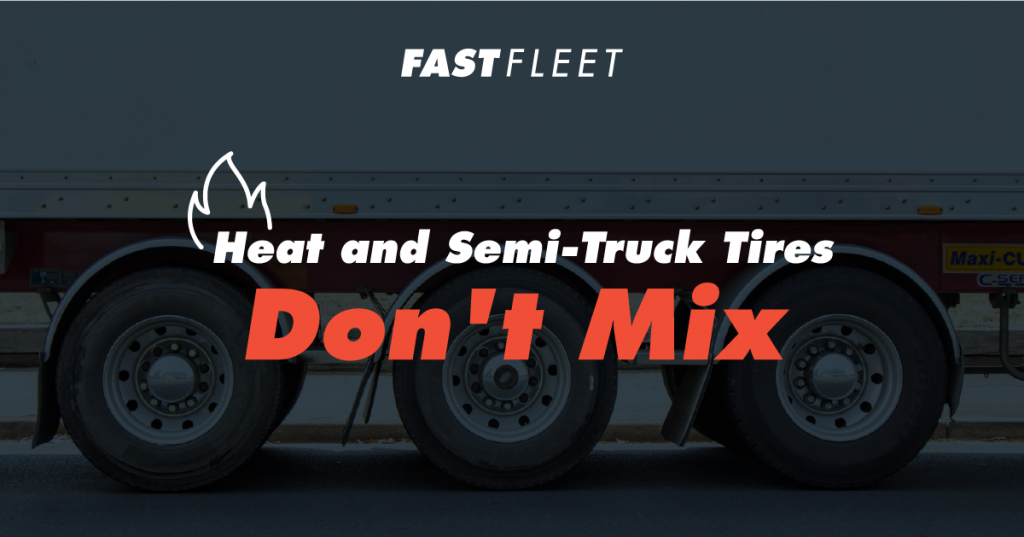A quick glance at the headlines is all it takes. Warmer temperatures are here (and getting higher year after year). From record-breaking heat waves and heat-related deaths in the Pacific Northwest to incredible sweltering heat in the South and the Southeast, the nation is heating up.
While that might be good news for swimming pool manufacturers and water park operators, it’s bad news for anyone who must be on the road. High temperatures cause havoc on vehicles, particularly tires, and nowhere is that more apparent than in the rapidly rising number of semi-trucks found littering the sides of the nation’s highways and interstates with blown tires.
A tire blowout is more than just an inconvenience, though. It costs time and money with the driver out and the load sitting there going nowhere. There’s also the chance that a blown tire could lead to an accident that damages the truck, trailer, or load.
A flat also litters the road with debris as dangerous as shrapnel, which can puncture tires on other vehicles. If the tire blew out and a passenger vehicle was in the right position, it’s even possible that it could cause an accident and that the driver and/or trucking company could be found at fault.
How does heat cause all these issues? It’s really about the tire more than the heat, but there’s a lot to discuss. We’ll explore what you need to know below.
Heat Is a Tire’s Worst Enemy
Chances are good that you assume road miles are a tire’s worst enemy. After all, endless rolling across the blacktop wears away tread, eventually requiring tire replacement. That’s true, but it’s not the whole story. Heat can kill a tire far more quickly than driving can – even a brand-new tire can succumb to high temperatures.
The reason? Tires are made from rubber. Sure, there’s plenty of steel in the mix, but rubber is the primary construction material, even for semi-truck tires. And rubber doesn’t mix well with heat. Think about it – what happens when you get a piece of rubber too close to a heat source? It starts to melt. The same thing is true for truck tires.
It’s not just the rubber, either. Modern tire manufacturers use a wide range of ingredients and additives in their rubber formulations to achieve goals like better wear resistance, and those ingredients can also be susceptible to heat. So, what’s the critical range for truck tires? Even a temperature as (relatively) low as 200 degrees F can start the degradation process.
Tires: A Compromise in Design
Today’s tires are marvels of engineering, but they represent a compromise. They must be soft enough to roll while dealing with potholes and debris in the road. They must be strong enough to hold up to the occasional curb impact, and they need to withstand additional weight from loading. Throw in the ability to withstand speed and turns, and you can begin to see why tire construction is more about finding a middle path than going to extremes in terms of resistance to any single force.
Tread: A Catch-22
Tread is often seen as one of the most critical parts of a tire. It’s designed to help deal with rough terrain, handle water on the road by moving it out of the way, and more. As the tire is used, the tread wears down, providing a good indication of remaining use life. Once it reaches a certain level, the tire must be replaced by law.
To a casual eye, more tread would seem to be the better situation. However, that’s only the case when it comes to tire lifespan when the temperature is maintained properly. Tread is a solid mass of rubber around the outer rim of the tire’s body, and when it’s thick and new, it retains an incredible amount of heat. This is one reason that NASCAR drivers use “slicks” with no tread – the temperature even 2/32-in. of tread would hold could mean blowing out a tire during the first lap.
The Importance of Air Pressure
Air – it’s what keeps your truck’s tires rolling down the road. All tires rely on air, except for solid tires on specialty vehicles. However, air does more than just keep your tires inflated. It also helps cool them and keep them within the manufacturer’s specified temperature rating.
The challenge here for many truck drivers is ensuring that tires are properly inflated. Too much air and the internal pressure increase due to heat can make blowouts more likely. Underinflated tires are even more likely to experience catastrophic failure than overinflated tires, though. That’s because with less air inside them, the tire’s structure/posture suffers. Its footprint becomes elongated, and more rubber is in contact with the road at one time, dramatically increasing its rolling resistance. This drives the temperature increase, reduces fuel economy, shortens tire life, and increases the risk of a blowout.
Sources of Tire-Killing Heat
As you can see, heat is the enemy. Where does it come from though? One source we’ve already touched on – rolling resistance generated heat in underinflated tires. In fact, most tire blowouts are due to underinflation.
Other sources of heat include travel speed. Even the difference between 75 mph and 55 mph can cause a serious temperature spike. Add to those other factors commonly experienced by truck drivers, such as:
- Ambient temperatures of 100 degrees F or higher
- Driving on superheated roads
- Driving on overloaded tires
When you add speed and underinflation to the mix of factors above, the results are incredibly dangerous. The tire begins to separate – the tread pulling away, the steel belts giving way, and the tire going to pieces while the truck is rolling down the blacktop. In a best-case scenario, the truck driver will be able to ease over to the shoulder and await roadside service to replace the tire.
However, that does nothing about the debris now littering the road and threatening unsuspecting drivers. There is also the chance that, if the tire were in a steering position or the trailer was improperly loaded, it could result in an accident. Even in a best-case scenario, the driver is now stranded and waiting, customers are getting antsy, and safety and other risk factors begin to rise.
Strategies to Help You and Your Drivers Cope
There’s both good and bad news for those hoping to find a solution to the tire/heat issue. Let’s tackle the bad news first. Here it is:
The heat is going nowhere. And it looks like it’s going to get worse.
What does that mean? Simply put, every company with trucks on the road, including owner-operators who handle their own tire maintenance must have a plan in place to reduce the chances of heat-related tire failure and the impact of blowouts when they do occur.
Is it realistic to prevent blowouts completely? Not at all. If tires rely on air pressure for physical structure and the ability to roll, blowouts will always be a possibility.
Where does that leave you? It can be a frustrating, confusing position in which to find yourself, but there are two simple steps to take that can help ensure you’re able to roll with the punches, so to speak.
Create a Tire Strategy
The first step to mitigating the risk posed by rising temperatures and heat is to create a tire-related strategy and implement it. This applies whether you’re an owner-operator with a single truck, or you manage an entire fleet of semi-trucks.
What should your strategy consist of, though?
- Tire pressure knowledge: Make sure that drivers know (and are required to check) the tire pressure on their trucks and trailers. Every tire manufacturer publishes PSI ratings and truck manufacturers do the same. Make sure you’re using the correct load/inflation table to guarantee the right pressure based on the tire’s location and the specific load in question.
- Check regularly: Drivers must check tire pressure regularly. Tire pressure should be checked cold as even a few miles will change temperature and pressure considerably. Driving surface – concrete versus asphalt for instance, distance driven, speed, and load all play into tire temperature, which is why it’s critical that the pressure is checked when the tires are cold, and that they are not adjusted when warm (which could lead to underinflation, and all the problems mentioned previously).
Conversely, a tire checked at 70 degrees after cooling down from a day on the road may experience a much more dramatic drop during cold weather. In this case, a tire might show 10 PSI low, but it should not be adjusted – the tire needs to be brought up to 70 degrees and then checked, as adding air after a cold night could result in overinflation.
- The right technology: Manually checking the pressure on every truck and trailer tire can be time-consuming and annoying. Technology can simplify the process. Tire pressure monitoring systems (TPMS) can simplify things. Of course, installing a TPMS might be out of the question now – a cat’s eye system can give drivers the information they need at a glance.
- Monitor tire condition: It’s not enough to check tire pressure. Your drivers (or maintenance crew) also need to check tire condition. Sidewall cracks, recaps beginning to separate from the tire, broken belts, and bulges – these are all signs of imminent failure. In addition, regularly monitoring tire condition can also clue you in on other situations, like the need to align a truck.
- Replace tires regularly: Yes, tires are expensive however, so is having a driver sitting on the side of the road waiting for help to arrive. Tickets and at-fault accidents are even more expensive. Replace your tires when the tread reaches the legal limit (or before if possible).
Find a Roadside Assistance Solution
The second and arguably more important step is to make sure you have access to roadside assistance when a tire blows out. Without access to timely help, your driver and their load will be sitting on the side of the road for hours.
Can you really afford those delays? What about the damage those delays cause to your reputation? As a freight carrier, on-time delivery is critical to maintain. A freight carrier unable to meet delivery deadlines will have a hard time landing new clients and contracts.
Vigilance and Strategy
With the right strategy in place and an understanding of the dangers posed by underinflation, it’s possible to dramatically reduce the chances of a tire blowing out. Remember that heat is the most serious enemy of your tires and have a plan in place to ensure pressures and conditions are checked regularly, and to get sidelined drivers back on the road as quickly as possible.
















